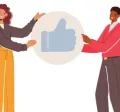
Creating an Effective Employee Rewards Program: Tips & Examples
28 July 2025
In the post-pandemic work environment, employees desire more than their paychecks. They crave appreciation. They want to be seen, valued, and celebrated, and that's where a thoughtfully designed employee rewards program suitable for the current working generation comes into play. In this blog, we are discussing how to create an effective employee rewards program, along with tips and examples.
Do you know that companies with strong recognition programs see a 31% lower turnover rate?
A great employee rewards program boosts confidence and improves retention. It conveys a simple but powerful message: “You belong here.”
Why Rewards Programs Matter
Motivates employees and enhances performance.
Employee rewards and recognition programs motivate employees to work harder and smarter. You know you will be rewarded if you do the right things the right way. Dale Carnegie once said, “People work for money but go the extra mile for recognition, praise, and rewards.” The extra mile motivates and improves team efficacy.
Creates a strong company culture
Employee reward programs create an irreplaceable work environment. All the big players of industry have money, machines, methods, and marketing techniques. They all want efficient and talented employees, and to appoint and retain them, they are focusing on a strong and supportive organisational culture.
Steers business success
A recognised employee is an engaged employee who can outperform their peers by up to 21% in profitability. (Gallup). Rewards are investments that increase efficiency and productivity, leading businesses towards exponential growth and success.
Inspires continuous feedback
An effective employee rewards program enhances open communication and encourages active praise, reinforcing learning and growth.
Steps to Create an Effective Rewards Program
Step 1: Well-defined purpose
Every strong reward system starts with well-defined and clear objectives. What is the outcome the company wants to receive after implementing the rewards system?
- Is it expecting enhanced performance or productivity?
- Does the company want to improve collaboration? Or
- Is it looking forward to increasing retention?
- The purpose should be aligned with business goals and employee needs.
Real-Life Example: Salesforce launched a rewards system to improve cross-team collaboration, rewarding teams—not just individuals—who worked across departments.
Step 2: Understanding employees
An exceptional reward system evolves with the employees. Surveys, quick polls, and suggestion boxes should be used to assess the needs and expectations of employees. Some questions can be
- Are the rewards meaningful?
- Do employees feel valued?
- What could we do better?
Real-Life Example: Adobe replaced annual performance reviews with ongoing feedback and recognition after discovering employees preferred real-time appreciation over year-end rewards.
Step 3: Types of Reward System
An organisation can choose a mix of monetary and non-monetary rewards, short-term motivation with long-term value.
Some are discussed below.
| Sl. No. | Type | Example | Best For |
| 1 | Monetary | Performance bonuses, referral incentives, spot/cash bonuses, profit sharing | Sales team, short-term motivation, high-performance roles. |
| 2 | Experimental | Paid vacations | Team bonding.celebrating team wins, creating culture. |
| 3 | Points-based reward system | Points system, rewards dashboard | Daily engagement.Digital-first companies |
| 4 | Wellness rewards programs | Spa Day, Yoga Day, Work Day Off | Reducing burnouts.Work-life balance.Mental and physical wellness.Gen Z and millennial employees. |
| 5 | Milestone-based | Awards aligned with company values | Celebrating milestones,Personal achievements,remote teams. |
| 6 | Recognition-based | Shout-outs on Slack or Teams, announcement of employees of the month | Team building.Culture developmentContinuous motivation. |
| 7 | Learning and Development Rewards | Career development | High-potential talentLong-term employee retentionCareer-focused employees. |
Step 4: Reward Criteria and Eligibility Rules.
Vagueness creates mistrust. The rewards program should clearly define the eligibility rules, nominating authorities, and the reward criteria for determining winners. It should maintain transparency and fairness.
Real-Life Example: Google has open nominations for recognition programs—where both peers and managers nominate others for their achievements.
Step 5: Define the scale and budget.
Start small. Try a pilot program with one team, one department. Take feedback and analyse. Calculate the cost of each type of reward, administrative expenses, and the cost of tools and platforms required. Discuss the ROI of the rewards system, i.e., link the rewards system to retention, performance, and culture metrics.
Real-Life Example: HubSpot tied their reward program proposal to retention improvements—and earned executive support by showing that it cost less than constant rehiring. Unilever piloted a flexible benefits system in one region—before rolling it out globally based on employee feedback.
Step 6: Determine a recognition platform.
Recognitions can use HR platforms, internal tools, or physical methods like certificates, events, ceremonies, etc. We need to select a simple, visible, and scalable recognition platform for all the employees.
Real-Life Example: LinkedIn uses an internal system where employees accumulate points for achievements and redeem them for their use or donations.
Step 7: Implement the rewards program.
The rewards plan should be implemented only if every employee is aware of what the program is all about and how they will participate. The performance matrix must be clear to avoid any confusion among the team members. Human resource personnel can host a webinar or launch an event using videos, infographics, and newsletters for implementing the rewards program.
Real-Life Example: Spotify introduced its new recognition platform with a themed launch called “Recognise & Rock On,” where employees shared appreciation notes via live screens.
Step 8: Monitor, measure, and improve.
Tracking success is pivotal. The metrics should add the employee participation rate, employee satisfaction, productivity, and engagement scores. The rewards program should evolve every three to six months to maintain its relevance and effectiveness.
Real-Life Example: Airbnb reviews its employee engagement dashboard quarterly, adjusting its recognition system based on surveys.
Step 9: Celebrate and share recognition.
Sharing employee recognition motivates everyone. Success stories at work can uplift morale and inculcate a sense of pride. It can be company-wide shout-outs, visual dashboards, or social media mentions.
Real-Life Example: Tata Consultancy Services (TCS) regularly highlights employee milestones in their newsletters and mobile apps—building a culture of visible celebration.
Mistakes to Avoid
Companies err while designing employee reward programs. For example, some focus only on high performers and ignore non-monetary rewards. At times, they are not aligned with company objectives and goals. Sometimes, the impact of rewards is not measured.
Additional Tips for Getting Started
Periodic survey to know what matters to the employees.
Listen to your employees. Identify employees’ requirements, and try to incorporate them into your rewards program.
Tie rewards with goals and missions.
Rewards programs should align with the goals and mission. It gives a clear view of what we are doing and why we are doing it.
Celebrate in real time.
Recognition delayed is recognition denied. Hence, ensure that appreciation occurs in real-time. Keep rewards handy on a real-time basis.
Every reward program should be linked to a reward and recognition suite. We, at Pluxee, celebrate employees’ brilliance and fuel their journey to excellence. We have tailored gifts with 5+ million RuPay-enabled outlets. The Pluxee India App is the highest-rated employee benefits app. It is perfect for special occasions. Celebrate your special occasions with our solutions. Also read https://www.pluxee.in/products/rewards-recognition/.





